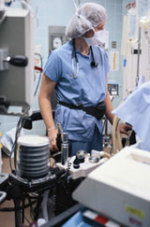Intérpretes del discurso del hospital del área de la bahía ayudados por Video- Conferencing
por
Michael Johns, Project Manager | July 21, 2006

Video teleconferencing puts
interpreter services where needed
May 30, 2006 (Computerworld) -- Videoconferencing has boosted the efficiency of speech interpreters at two public hospitals in the San Francisco Bay area, where 35 different patient languages pose a challenge to health care providers.
More than half of the patients at Alameda County Medical Center and San Francisco General Hospital have limited English proficiency, so the health care centers employ in-house interpreters to make sure that doctors' orders and medication regimes are understood and followed.
To extend the reach of the interpretation services at a number of facilities miles apart, the hospitals have used $1.5 million in grants to set up the Video Medical Interpretation Project. Under the initiative, networking gear and videoconferencing cameras and monitors have been set up, cutting the time an interpreter must spend per patient in half, mainly due to reduced travel and wait time for interpreters, Janice Chin, director of interpretation services at Alameda and the VMI program manager, said in an interview last week.
At Alameda, the average time interpreters spend per patient has dropped to 17 minutes, down from 37 minutes, Chin said. That reduction in time is equivalent to about $420,000 in personnel costs for one year, said Gloria Orme, a registered nurse and director of operations, primary care, patient advocacy and interpreter services at San Francisco General.
"Of course, we really don't save the money -- instead we save the time, and the result is more timely interpretation for our patients," Orme said.
Patients, medical staff and interpreters are highly satisfied with the service, according to interviews and surveys done by the hospitals.
"When I first heard of VMI, I said, `Oh, my God,' but I was surprised the very first time and [saw] this [system] is only a monitor," Maria Barajas, a speech interpreter at San Francisco General, said in a recorded panel discussion about the project.
"Patients are not afraid and quickly adapt. I really feel comfortable using it. I would tell any interpreters out there not to be frightened. It's really good," Barajas added.
The system relies on Cisco Systems Inc. routers, switches and IP phones, as well as Cisco Call Manager software for the Interpretive Services call center. Videoconferencing is provided by Tandberg in New York, with the Tandberg 1000-MXP system in use in about 30 locations in the two hospitals, Chin said. The Tandberg 1000 MXP can be wheeled into various rooms in a hospital facility and contains a 12-in. screen with speakers, camera and microphone all contained in a single unit, according to Tandberg's Web site.
